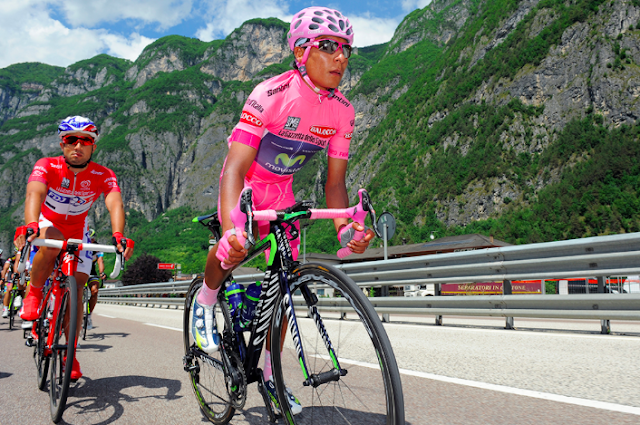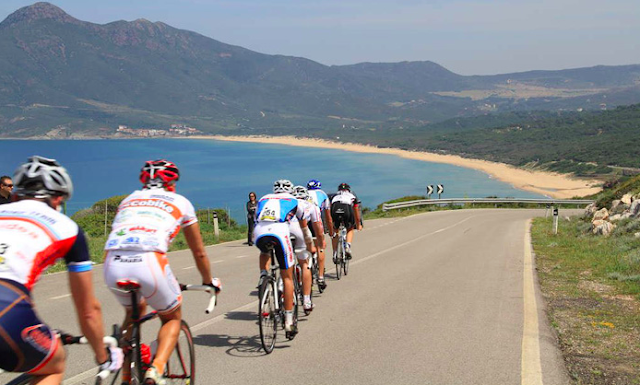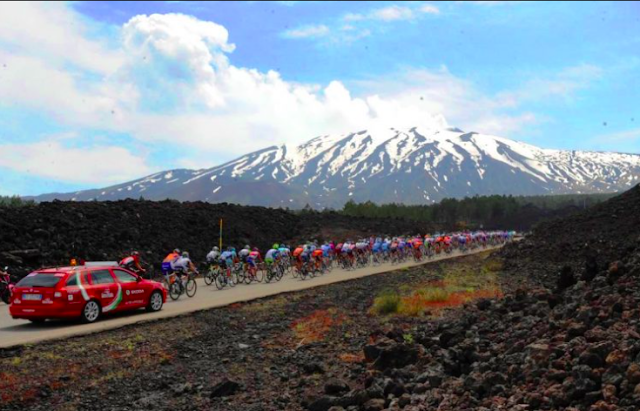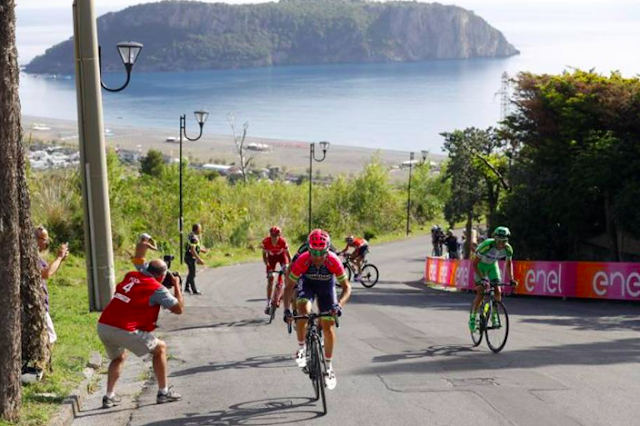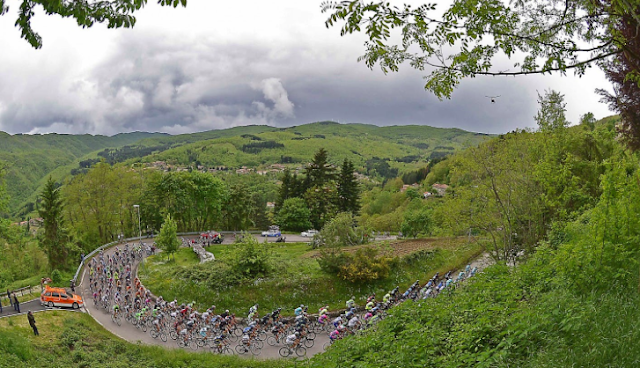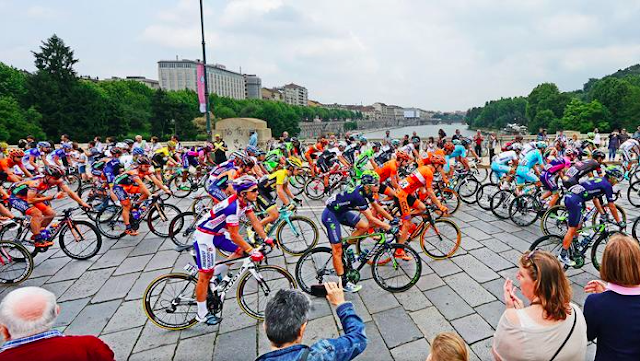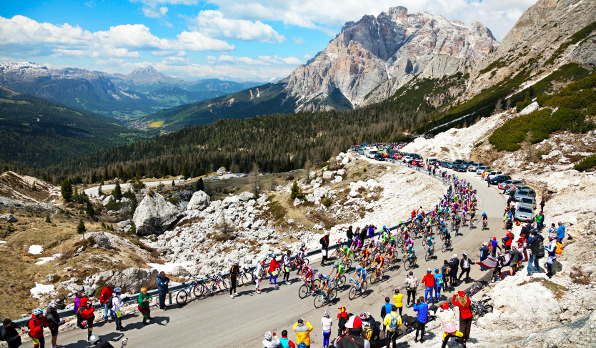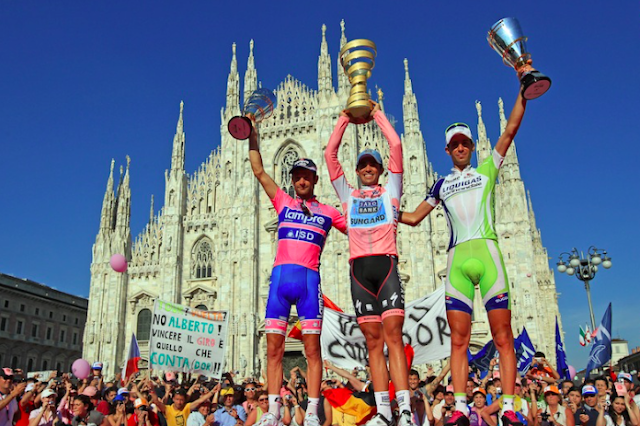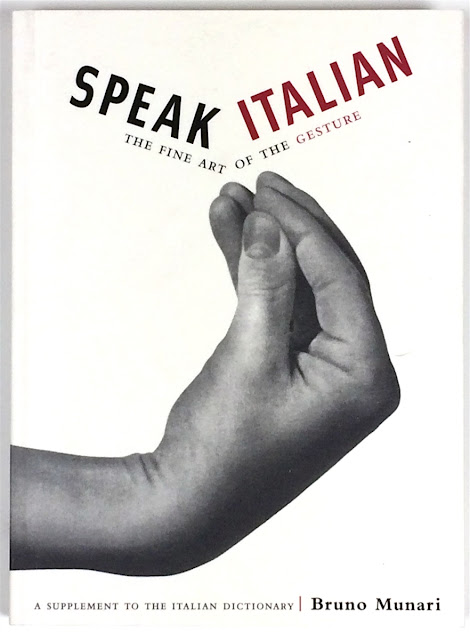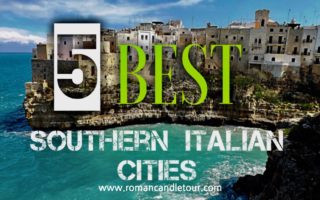A Traveler’s Guide To The 2017 Giro D’italia
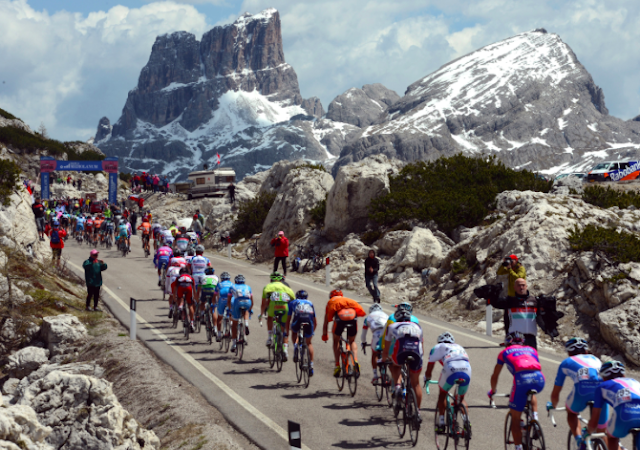
The riders race close to 200 kilometers per day which translates to several hours in the saddle. The beginning stages are flatter and geared toward the sprinters, who can drop out when they need to, usually before heading to the mountains. Cyclists are forced to abandon each year, because of physical necessity, painful injuries, or if they don’t make the time cut at the end of each stage. Even for the climbers, it’s a fight for survival.
For spectators, the mountain stages are truly thrilling to watch. Italian locals come out of tiny villages to cheer on the racers with bright banners and yelling, ‘Vai, vai!’. The precarious roads snake up steep faces of impressively tall snowcapped mountains. Along with flat, hilly, and mountain stages, there are two individual time trials, where cyclists race against the clock rather than side by side, and three rest days.
Cyclists compete together as teams, but after the final stage, one individual team member is the overall winner. Typically, only a few individuals from top teams fight for the general classification, while the others compete in the points, mountains, and young rider classifications. At the end of each stage the classification leaders are announced and awarded designated jerseys to be worn during the next day of racing.
The general classification leader, which is determined by a combination of the lowest overall time and the most points accumulated, is awarded the pink jersey. The rider who holds onto the ‘maglia rosa’ after the final stage of the Giro is the overall race winner. Why pink? The ‘maglia rosa’ pays homage to the race’s founder, ‘La Gazetta della Sport,’ an Italian sports journal which was originally printed on pink paper.
Points are awarded for stage wins as well as to the riders who come in second to fifteenth place. Riders can also accumulate points by being the first of several to reach designated spots on each route. Full of fire and spirit, the points classification leader wears red with the ‘maglia rossa.’
In the mountain classification, points are awarded to the first several riders who reach the top of substantial, predetermined climbs. The “king of the mountains” is always the first to see the sky at each peak, so he wears blue with the ‘maglia azzurra.’
The young rider classification applies to the fresh, bold riders under the age of twenty- five. The leader is determined in the same way as the general classification and because of their innocence and inexperience compared to race veterans, this rider is awarded the white jersey or ‘maglia bianca.’
Not only is the 2017 Giro going to be one of the toughest, most exhilarating competitions, it is the perfect backbone for a one-of-a-kind trip to Italy. Whether you are a keen cyclist, general sports enthusiasts, or curious soul, yearning to experience something new and utterly gripping, the Giro is the perfect way to explore the entire country.
This year’s course will take us through seventeen of Italy’s twenty-one regions. Follow the bike race from the islands of Sardinia and Sicily to Italy’s “boot,” then head north to Florence and Turin, climb up through the Alps and Dolomites, and eventually finish in the spectacular city center of Milan. Below the perfect Giro-Italy trip is laid out for you as well as some useful Italian vocabulary.
Sardinia
The first three stages of the Giro are in Sardinia. May 5th starts the riders off on a hilly first day of racing. ‘La partenza’ or the start in Alghero is a must-see; the riders will have those pre-race jitters and the whole country will be on edge, anticipating a spectacular tour. Stage two is likely to have our first exciting finish, as the route is flat or downhill, perfect for a sprint finish. Head to Tortolì to catch the sprint live.
Stage three will be relatively flat, which may not sound exciting, but watch out for those ‘fugue’ or breakaways from riders looking to gain some time in the general classification. During stage three, take a break from the race to take in the Sardinian sunshine and scenery. The next day, May 8th is a rest day, so use this day to follow the tour to Sicily.
Sicily
Head to Palermo, Sicily’s capital and enjoy the Arabic-inspired architecture, outdoor markets, and as much fresh fish and ‘granita,’ a refreshing frozen treat, as you can. On the morning of stage four take the train from Palermo to Cefalù, one of Sicily’s most visited beaches, usually full of brightly coloured umbrellas and street vendors, where the stage starts.
The riders will need extra encouragement as this day is the first high difficulty stage with lots of climbing. They will gain about 3,500 meters in elevation as they climb from the shore up the slopes of Mount Etna, Europe’s tallest active volcano. This will be the first mountain top finish of the Giro. Spend an hour or two at the beach, but then get to Etna to see the racers grind those pedals up the volcano.
Stage five from Predara to Messina is a relatively flat stage, so spend the day as you wish in Sicily. However, if you want to catch the likely sprint finish, make your way to Messina. As Sicily’s third largest city, you can also visit the cathedral and wander around its many beautiful churches, fountains, and ‘palazzi.’
Calabria
Hop on a plane to the sun-kissed region of Calabria on the morning of May 11th. In stage six riders face an ever-changing route with two long climbs, a flat portion along the coastline, and then three short climbs just before the ‘traguardo’ or finish line in Terme Luigiane.
The next stages that meander through the south and up central Italy are worth skipping. Stage seven in Calabria is flat. Stage eight and nine are hilly, but we have more exhilarating climbing to come and there is a rest day in-between these two. Stage ten starting in Umbria is the first of two individual time trials.
Take a few days to explore the “boot” and coastlines of Italy. Visit Calabria’s ‘Museo Archeologico Nazionale’ and the breath-taking beaches with turquoise waters and stunning cliffs. Go to Puglia to see some of the most beautiful Mediterranean coastline containing bleached white walled houses with colourful roofs. Even better, head north to spend a day in paradise on the idyllic Amalfi Coast and as you continue upwards, stop in Naples for a perfectly baked, doughy, tomato, mozzarella, and basil topped pizza.
Florence and San Gimignano
On May 16th, make your way to Florence by train or car. Prepare to indulge in rich Tuscan food, warming glasses of ‘Chianti,’ and endless classical art and architecture. Stage 11 on May 17th begins in this medieval town, once the jewel of Italy, at Ponte a Ema and ends in Bagno di Romagna near Bologna. The route is a little more than a hilly stage with mild climbs. Watch the riders as they set off and then explore Florence’s ‘Ponte Vecchio,’ ‘Il Duomo,’ the statue of David, and the many historical museums and galleries.
We are skipping stages twelve through fifteen to stay in Florence and explore Tuscany. Choose one day to adventure outside of Florence, passed the quintessential vineyards to the small picturesque town of San Gimignano. It will feel like you have gone back in time to when people lived in castles and feasted wearing embroidered dresses and shining armor. Walk around the cobbled streets and artisanal shops. Have a long lunch before the sun fades.
Turin
Next, the riders will be heading north, so during stage fifteen drive to Turin. Stop in Modena, a small city known for balsamic vinegar and Italian sports car production, for lunch and to stretch your legs. If you have a need for speed and miss the Giro racing already, go to the ‘Museo Enzo Ferrari’ to learn about the history of Ferrari. Spend May 22nd, the rider’s second rest day, in Turin soaking up the Baroque architecture.
The Alps and Dolomites
Stage sixteen is where the true climbing of the Giro begins. It continues all the way through stage twenty. This is the most exciting point in the Giro! Riders will be battling it out for mere centimeters on the slopes and seconds on the clock. Only stage seventeen has slightly milder climbing, so if you need a break, this ones is best to miss.
During stage sixteen, riders will weave through the Alps, even entering and exiting Switzerland, and ascend the highest climb of the Giro reaching an elevation of 2,758 meters. Stage eighteen is predicted to be the most gruelling day of racing. The riders will need your support, so find a spot in the Dolomites to cheer. This stage will have five check points where the top climbers will battle for points in the mountain classification.
Piancavello in stage nineteen will host the final mountain top finish of the Giro. Go and watch at the top! The last day of climbing is stage twenty and if you can’t make it to a slope, at least see the start at Pordenone. Then head to Milan for the final stage.
Milan
The last day of racing is a twenty-eight kilometer time trial that begins with a lap around ‘Autodromo Nazionale Monza,’ a classic car racetrack built in 1922 and ends in the ‘Piazza del Duomo’ next to Milan’s epic Gothic cathedral. Since riders will be starting one by one, explore the whole route and watch from different places throughout the day. Once all the riders have finished, head to the podium for the official announcements of the overall winner and winners of the classifications. Be prepared to celebrate in a shower of champagne!
2017 Giro-Italy Trip
May 3 – 4: Travel to Italy!
May 4: Arrive in Sardinia
May 5 – 7: Sardinia
Stage 1 Alghero – Olbia
Stage 2 Olbia – Tortolì
Stage 3 Tortolì – Cagliari
May 8: Riders’ rest day / Travel to Sicily
May 9 – 10: Sicily
Stage 4: Cefalù – Etna
Stage 5: Pedara – Messina
May 11: Calabria
Stage 6: Reggio Calabria – Terme Luigiane
May 12 – 15: Explore Calabria, Puglia, Naples (skip stages 7, 8, and 9, May 15 is a rest day)
May 16: Travel to Florence (skip stage 10)
May 17: Florence
Stage 11: Firenze – Bagno di Romagna
May 18 – 20: Explore Florence and San Gimignano (skip stages 12, 13, and 14)
May 21: Travel to Turin – stop in Modena and explore Turin (skip stage 15)
May 22: Riders’ rest day / Explore Turin and travel to the Alps
May 23 – 27: The Alps and Dolomites
Stage 16: Rovetta – Bormio
Stage 17: Tirano – Canazei (best mountain stage to skip) Stage 18: Moena – Ortisei/St. Urlich
Stage 19: San Candido/Innichen – Piancavallo
Stage 20: Pordenone – Asiago
May 27: Travel to Milan after watching start of Stage 20 at Pordeone
May 28: Milan
Stage 21: Monza – Milano (time trial)
May 29 – 30: Explore Milan
May 31: Travel home!
Italian to Know
Cheers:
‘Vai, vai!’ = ‘Go, go!’
‘Dai!’ = ‘C’mon!’
‘Viva!’ = literally meaning ‘live,’ this is often painted on roads to cheer on cyclists
‘Su!’ = meaning ‘up’ this is used to urge riders to catch others in front of them or get up a climb
People:
‘I tifosi’ = the spectators (you!)
‘Il gruppo’ = ‘the peloton’ or the largest pack of riders
‘La fuga’ = the breakaway
‘I fugitivi’ = literally ‘the fugatives,’ these are the breakaway riders
‘Il gruppo compacto’ = when the riders are together or when the pelaton catches a breakaway ‘Il gruppo frazionato’ = when the peloton breaks up into smaller groups, ‘il primo,’ the first, ‘il segundo,’ the second, and ‘i gruppetti,’ the smaller groups
‘Il gruppo spaccato’ = when the peloton has been ripped apart and riders are spaced out
Racing:
‘La partenza’ = the start
‘Il traguardo’ = the finish line
‘Cima coppi’ = the highest climb of the Giro, the rider who finishes first wins this title and points ‘Volata’ = literally meaning ‘flight,’ this is for stages that finish in a sprint
‘Piano’ = ‘flat’ for when a stage is flat without much climbing
‘Sali-scendi’ = ‘rising-falling’ for hilly stages where riders are constantly climbing and descending ‘Dicesa tecnica’ = ‘technical descent’ or difficult downhills that call for impeccable bike handling skills so riders can successfully navigate the steep, narrow, twisting roads and don’t crash
Pain:
‘Perdere le ruote’ = ‘Lose the wheel,’ when a rider can’t keep up and is dropped from the group ‘Giornata no’ = a ‘no day,’ when a rider had a chance, but now won’t win or perform well that day ‘Crisi’ = literally meaning ‘crisis,’ also called ‘bonking,’ it’s when a rider has no energy left either because he initially went to fast or hard, needs more fuel, or simply is exhausted
Written by: Becky Heeley
If you liked this article, read also “THE DAZZLE AND THE BELLEZZA: WHAT MILAN FASHION WEEK HOLDS FOR YOU“
